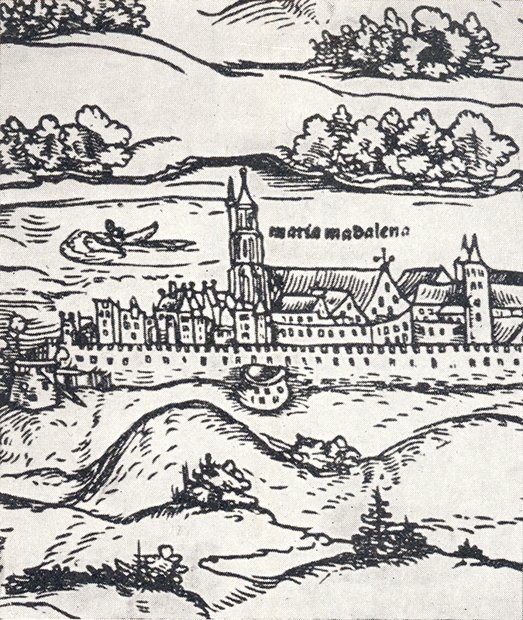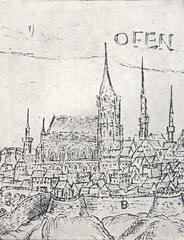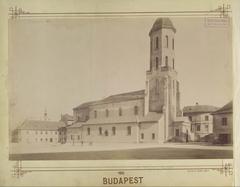
Church of Saint Mary Magdalene, Budapest: Visiting Hours, Tickets, and Historical Sites Guide
Date: 03/07/2025
Introduction
Nestled in the heart of Budapest’s historic Castle District, the Church of Saint Mary Magdalene (Mária Magdolna-templom) stands as a compelling testament to Hungary’s intricate history and architectural evolution. Originating in the 13th century, this church has witnessed centuries of religious, political, and cultural transformation—from its Romanesque beginnings and Gothic flourishes to its time as an Ottoman mosque, Baroque renovations, and postwar ruins. Today, its preserved Gothic tower and evocative remains offer visitors a serene setting and a deep connection to Budapest’s past.
This comprehensive guide covers essential visitor information—including current visiting hours, ticketing, accessibility, and nearby attractions—while providing an in-depth look at the church’s historical context, architectural highlights, and cultural significance. Whether you are a history enthusiast, architecture lover, or an explorer of Budapest’s hidden gems, the Church of Saint Mary Magdalene promises a memorable and enlightening experience. For the latest visiting details and event schedules, always refer to the official museum website and Budapest tourism portals.
Table of Contents
- Historical Overview
- Architectural Highlights
- Visitor Information
- What to See and Do
- Nearby Attractions and Suggested Itineraries
- Practical Tips
- Frequently Asked Questions (FAQ)
- Conclusion
- References and Further Reading
Historical Overview
Medieval Foundations
The Church of Saint Mary Magdalene traces its origins to the mid-13th century, following the Mongol invasion of Hungary. Built primarily to serve the Hungarian-speaking Catholic community of Buda—while the nearby Matthias Church catered to German-speakers—it stands as one of Budapest’s oldest ecclesiastical structures (Evendo). The original Romanesque church soon embraced Gothic features, evident in its pointed arches, ribbed vaults, and slender windows. The prominent four-story Gothic bell tower, with its lancet windows and stone tracery, remains a significant architectural survivor.
Ottoman Era and Transformation
The 16th-century Ottoman conquest of Buda brought dramatic changes. The church was converted into a mosque, with Christian iconography removed and the interior adapted for Islamic worship. Although the minaret from this period no longer survives, the building’s adaptation illustrates the city’s layered religious history and its role as a crossroad of civilizations (Evendo).
Habsburg Restoration and Baroque Modifications
After the Habsburgs recaptured Buda in 1686, the church was rededicated for Catholic worship. Baroque modifications revitalized the structure, adding decorative chapels and a Neoclassical entrance portal for the 1792 coronation of Francis II as King of Hungary. Despite these changes, many Gothic elements were preserved, creating a visually rich and historically resonant blend (offbeatbudapest.com).
Destruction and Preservation in the 20th Century
World War II inflicted severe damage, especially during the 1944–45 Siege of Budapest. Much of the nave and interior were destroyed, and postwar policies led to further demolition, sparing only the tower and some side walls (offbeatbudapest.com). In recent decades, preservation efforts have stabilized the ruins, and the site is now recognized as a key landmark in Budapest’s historic landscape.
Architectural Highlights
- Gothic Tower: The church’s most iconic feature, with four stories of pointed arches and intricate masonry, offers a rare glimpse into medieval Hungary’s architectural heritage (intravel.net).
- Nave Ruins: Portions of the nave and side walls survive, revealing the scale and layout of the original church.
- Exhibition Space: Inside the tower, visitors find informative displays detailing the church’s history, architectural fragments, and archival photographs.
- Atmospheric Ambience: The open nave and exposed stonework create a contemplative atmosphere, especially when contrasted with the lively Castle District surroundings.
Visitor Information
Visiting Hours and Tickets
- Opening Hours:
As of July 2025, the Church of Saint Mary Magdalene is generally open Tuesday–Sunday, 10:00 AM–6:00 PM. Some sources cite slightly shorter hours (10:00–4:00 PM), so always check the official website before your visit. - Tickets:
- Adults: HUF 1,500
- Students/Seniors: HUF 900
- Children under six: Free
Discounts and family tickets may be available. Tickets include access to the tower and exhibitions (BookInBudapest).
- Where to Buy: Tickets can be purchased on-site or online via authorized platforms.
Accessibility
- The ground-level ruins and exhibition are accessible to most visitors.
- The tower climb involves approximately 170–172 narrow spiral steps and is not suitable for wheelchairs or those with mobility challenges.
- Public transportation (buses 16, 16A, and 116) serves the Castle District, stopping at Kapisztrán tér, just steps from the church (BookInBudapest).
Guided Tours and Interpretation
- While regular guided tours are uncommon, special tours and cultural events are occasionally offered, especially during festivals.
- Multilingual information panels and exhibitions provide rich historical context for self-guided visitors (XpatLoop).
What to See and Do
Tower Climb and Panoramic Views
The highlight for many visitors is climbing the restored Gothic bell tower. The ascent (about 170 steps) leads to a viewing platform with panoramic vistas of Budapest, the Danube, and the Buda Hills (Buda Castle Budapest). The climb is moderately strenuous, so wear comfortable shoes and be prepared for a narrow, winding staircase.
Ruins, Exhibitions, and Events
- Explore the Ruins: The open nave and surviving chancel reveal the church’s medieval origins. Informative exhibits illustrate its history as a Catholic parish, Ottoman mosque, and postwar ruin (Daily News Hungary).
- Temporary Exhibitions: Cultural and historical exhibitions are regularly hosted within the tower, often focusing on Budapest’s rich heritage (XpatLoop).
- Concerts and Events: The church’s unique acoustics make it a favored venue for classical music and choral performances. Check the official website for event schedules.
Nearby Attractions and Suggested Itineraries
- Buda Castle: Explore museums and the Hungarian National Gallery.
- Matthias Church: Renowned for its colorful roof and ornate interior.
- Fisherman’s Bastion: Offers fairy-tale turrets and panoramic views.
- Military History Museum: Just 85 meters from the church (BookInBudapest).
- Other Sites: Medieval Synagogue, Lutheran Church of Budavár, and Hospital in the Rock Museum are all within walking distance.
Suggested Itinerary:
Begin with a morning visit to Buda Castle, explore the Church of Saint Mary Magdalene by midday, and end at Fisherman’s Bastion for sunset views.
Practical Tips
- Best Time: Early mornings and late afternoons are quieter and offer the best lighting for photography.
- Weather: The tower is exposed; bring appropriate clothing for wind or rain.
- Facilities: Restrooms are available nearby but may be limited.
- Language: Exhibitions and signage are in Hungarian and English.
- Photography: Permitted for personal use; commercial photography requires prior approval.
- Children: Welcome, but supervise them carefully during the tower climb.
- Health: The climb is not recommended for those with heart or respiratory conditions.
Frequently Asked Questions (FAQ)
Q: What are the current visiting hours for the Church of Saint Mary Magdalene?
A: Typically Tuesday–Sunday, 10:00 AM–6:00 PM. Hours may vary; confirm on the official website.
Q: How much are tickets?
A: Adults: HUF 1,500; Students/Seniors: HUF 900; Children under six: free.
Q: Is the tower climb suitable for children or those with mobility issues?
A: Children in good health can climb with supervision. The climb is not advised for those with mobility impairments.
Q: Are guided tours available?
A: Occasionally, especially during festivals or special occasions. Most visits are self-guided.
Q: Can I take photos in the church and from the tower?
A: Yes, for personal use. Please respect restrictions during exhibitions or events.
Conclusion
The Church of Saint Mary Magdalene is a remarkable symbol of Budapest’s resilience, diversity, and architectural splendor. Its storied past—from medieval parish to Ottoman mosque, Baroque church, and wartime ruin—mirrors the city’s own complex history. Today, visitors can enjoy a tranquil, reflective experience, panoramic city views, and immersive exhibitions that bring centuries of history to life.
For the most current information on opening times, tickets, and events, always consult the official museum website and Budapest tourism resources. Enhance your visit through digital resources like the Audiala app for self-guided audio tours, and explore related posts about Budapest’s historic sites for further inspiration.
Suggested Visuals
- Exterior photo of the Gothic tower with alt text: “Gothic tower of Church of Saint Mary Magdalene in Budapest”
- Panoramic view from the tower with alt text: “Panoramic view of Budapest from the Church of Saint Mary Magdalene”
- Interior images of the nave ruins and exhibition panels
- Map highlighting the church’s location within the Castle District and nearby attractions
References and Further Reading
- Church of Saint Mary Magdalene in Budapest: Visiting Hours, Tickets, and Historical Insights (Evendo)
- Church of Saint Mary Magdalene: Hours, Tickets, and Historical Insights (offbeatbudapest.com)
- Visiting Information (intravel.net)
- Official Visitor Information (Budapestinfo)
- Museum Website (Vármúzeum)
- Insider’s Guide (XpatLoop)
- Mary Magdalene Tower (BookInBudapest)
- Buda Castle and Mary Magdalene Church Tower (Buda Castle Budapest)
- Medieval Sacred Ruins in Budapest (Daily News Hungary)
- Medieval Jewish House of Prayer (Medieval Jewish House of Prayer)
- In Budapest, a medieval synagogue dormant for hundreds of years is rededicated (Times of Israel)









































































































































































